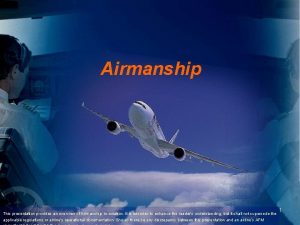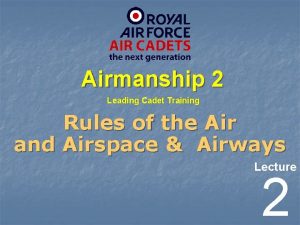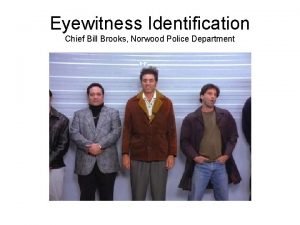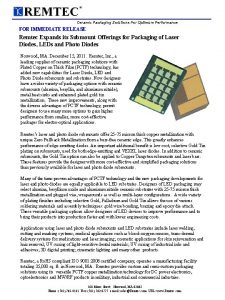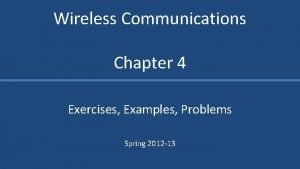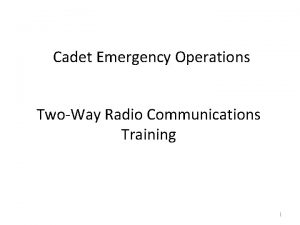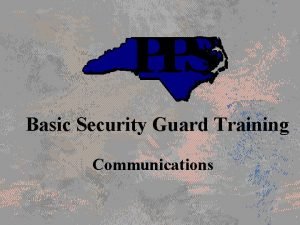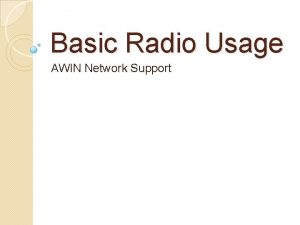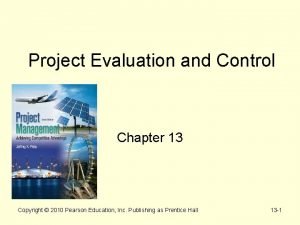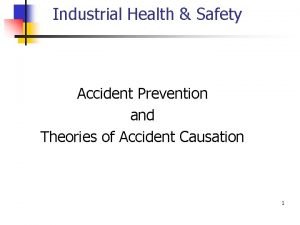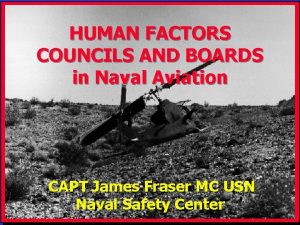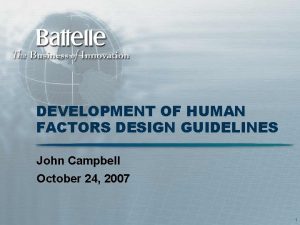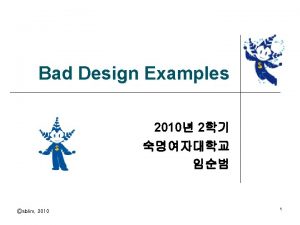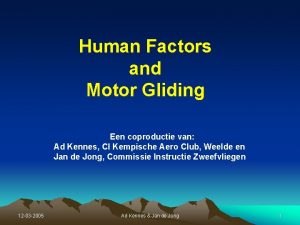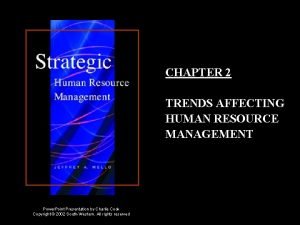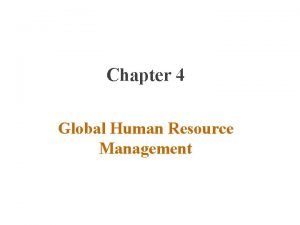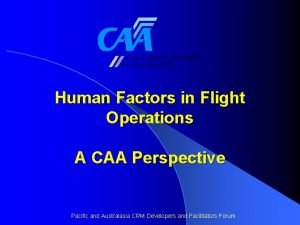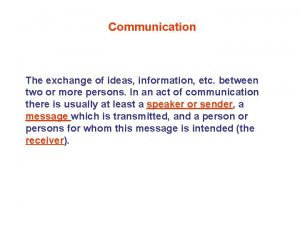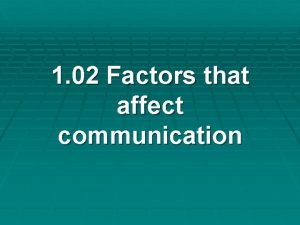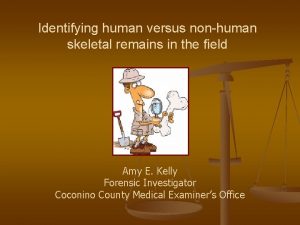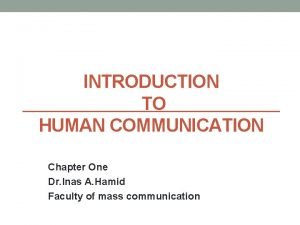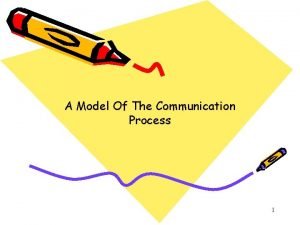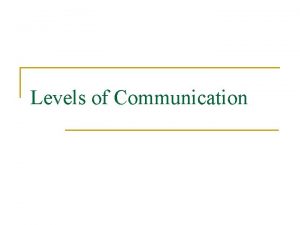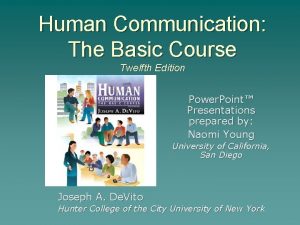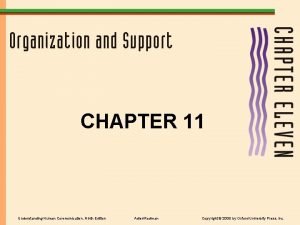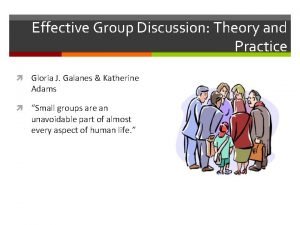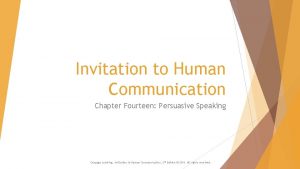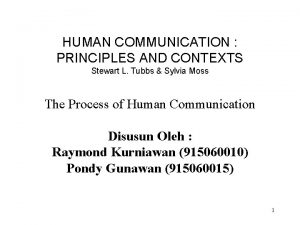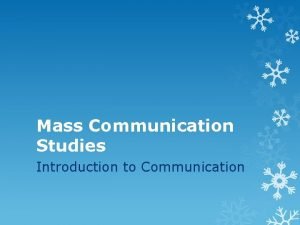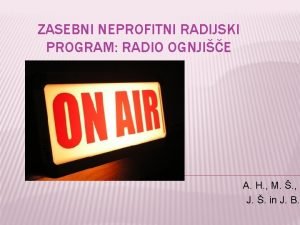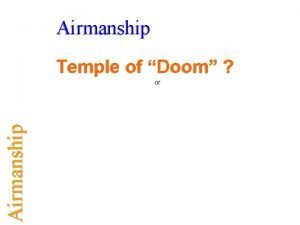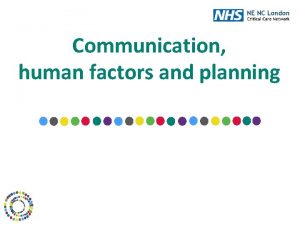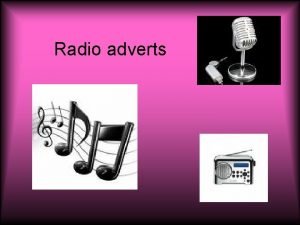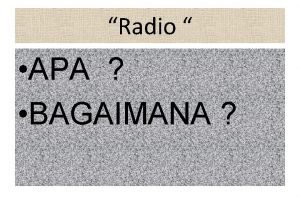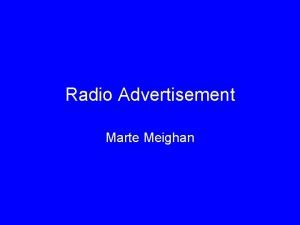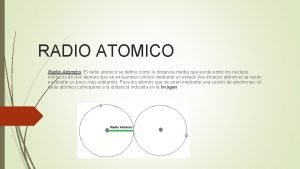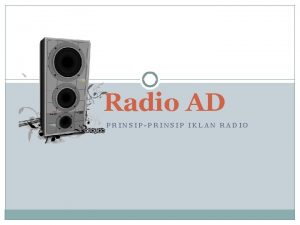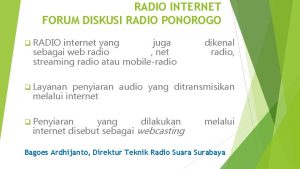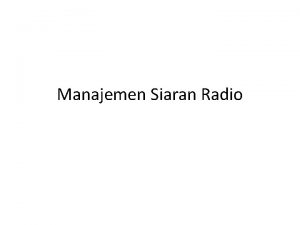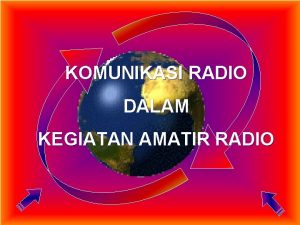CI M Norwood Airmanship Human Factors Radio Communication







































































- Slides: 71

CI M Norwood Airmanship, Human Factors & Radio Communication References: FTGU Pages 259 - 314

Review 1. What type of projection is used for a VNC? 2. What is a magnetic heading? 3. What is the length of a nautical mile?

Topics to be Covered • • Wake Turbulence Human Factors Radio Waves and Signals Radio Phraseology and Procedures

Wake Turbulence • As the lift producing airfoil passes through the air, the air rolls up and back each wing tip producing two distinct counter rotating vortices, one trailing each wing tip. • The intensity of the turbulence within these vortices is directly proportional to its weight and inversely proportional to its wing span and speed of the airplane. • In cold air the vortices can be expected to be more severe.


Wake Turbulence • The strength of a vortex is governed by several factors • The vortex strength will increase as: – Weight Increases – Speed Decreases – Drag Decreases

Wake Turbulence • Other factors that affect vortex strength include: – Configuration of the aircraft – Position of flaps – Position of landing gear – Location of the engines – Configuration of the tail • The strongest vortex will occur when an aircraft is:


Hazards of Wake Turbulence • Vertical gusts encountered when crossing laterally through the vortex can impose structural loads as high as ten G’s on a small airplane. • The combination of upward and downward gusts has been estimated as high as 80’/sec. • Most small airplanes are designed to handle 30’/sec

Structural Damage • There is also a possibility of structural failure when an aircraft crosses a pair of vortices. • The strong up and down forces combined and the pilot’s attempt to counteract them will result in loss of control and airframe design limits being exceeded.

Vortex Generation • Vortex generation starts at rotation (the raising of the nose from the runway) and increases in intensity at lift off when the full weight of the aircraft is sustained by the wings • It ends when the airplane touches down • Vortices may trail as far as 10 to 16 miles depending on the airspeed of the aircraft • Wake turbulence usually dissipates after two minutes, but can remain as long as five minutes

Crosswind Effects • Vortices tend to move laterally outward over the ground at a speed of about 5 knots • This means that the vortices may position themselves parallel to the runway and constitute a hazard to aircraft operating in that area • Crosswind effects wake turbulence. The stronger the cross wind, the more vortices get blown to the side.

Wake Turbulence Avoidance • During Flight – Although wake turbulence is most likely to be encountered during arrival and departure, it can be a hazard at cruising altitudes as well – Avoid crossing behind and less than 1000’ below the flight path of large, heavy a/c especially at low altitudes

Wake Turbulence Avoidance • During Taxi – Stay well behind large aircraft that are taxiing or maneuvering on the ground – Avoid going behind aircraft doing a run-up – Avoid taxiing below a hovering helicopter (the down wash is significant and hazardous).

Wake Turbulence Avoidance • During Take-off – Stay up wind of larger aircraft – This will keep you above the descending vortices of the descending airplane – When following an aircraft that has just landed plan to be airborne beyond the point of touchdown of that aircraft – For an intersecting runway, plan to be airborne before you cross the intersection.

Wake Turbulence Avoidance • During Landing – When following a heavier aircraft that has just taken off, plan to touch down before the rotation point – When following an aircraft that has just landed plan to touch down beyond the point where the preceding aircraft touched down.


Wake Turbulence Avoidance • Above all – Avoid a long dragged in approach – Largest number of dangerous encounters with wake turbulence has been in the last half minute of approach • Wait at least 2 minutes before landing or taking off behind another aircraft

Wake Turbulence Avoidance • ATC Advisories – ATC can not guarantee that wake turbulence will not be encountered. – When the ATC advises, “CAUTION WAKE TURBULENCE”, they are warning you of the possible existence of wake turbulence.

Avoidance Responsibility • Wake turbulence avoidance is the sole responsibility of the Pilot in Command • Even though you may have received a clearance to land or take-off it is your responsibility to ensure that no wake turbulence hazard exists • When in doubt, advise the controller that you would like to wait until the risk of wake turbulence has passed.

Accidents and Incidents • Occurrence: Any accident or incident relating to the operation of an aircraft • Accident: An accident related to the use of an aircraft in which: – A person is seriously injured or killed – An aircraft sustains substantial damage which affect its structural strength, performance or flight characteristics or is reported lost or inaccessible

Aviation Incident • • Engine failure Radio failure Smoke or fire Difficulties controlling the aircraft • The aircraft departs the intended take-off or landing area • Flight crew incapable of performing duties • Depressurization • Fuel starvation. • Refueled with incorrect or with contaminated fuel. • A collision or loss of separation occurs between aircraft • An emergency is declared • Dangerous goods are spilled within the aircraft or are released from the aircraft.

SAFTEY

TSB • Transportation Safety Board – Performs investigations following accident/incident

Seats, Harness and Safety Belts • Safety belts: must have safety belt for each person on board other than infant • At least one pilot at the controls at all times during flight

Human Factors

Hypoxia • Hypoxia is a lack of sufficient oxygen in the body cells or tissues • The Canadian Aviation Regulations state that when flying, by day, between 10, 000 feet and 13, 000 feet for more than 30 minutes or above 13, 000 feet, you must carry a supply of oxygen of at least 2 hours for every crew member.

Hypoxia • Symptoms of hypoxia include: – A sense of euphoria – Reduced vision – Confusion – Inability to concentrate – Impaired judgment and reflexes – Eventual loss of consciousness

Blood Donation – It is recommended that pilots wait at least 48 hours before flying after donating blood (AIR 3. 14)

Scuba Diving • After non-decompression dives, flights up to altitudes of 8, 000 ft ASL should be avoided for 12 hours • Where decompression stops have been required before returning to surface, wait 24 hours • Flights above 8, 000 ft ASL wait 24 hours, regardless of type of dive

Alcohol • CARs require that a pilot allow at least 8 hours between the consumption of alcohol and flying • Most companies say 12 hours • 48 hours after excessive drinking • NO ALCOHOL IN THE SYSTEM WHEN YOU FLY!!

Drugs • Do not self-medicate • Drugs, as well as the conditions for which they are taken, can interfere with the efficiency of the pilot and can be extremely dangerous • Contact your aviation medical examiner prior to flying if taking any medication which you suspect may impair your abilities

Anesthesia • With spinal or general anesthetics, or with serious operations, you should not fly until your doctor says it is safe. • After local anesthetic, you should wait 24 hours before flying • AIR 3. 13

Disorientation and Vertigo • Spatial disorientation: refers to loss of directional awareness or confusion regarding actual position or movement relative to the ground • Flicker vertigo: phenomenon which may occur when a single-engine aircraft is descending directly into the setting sun

Review • When do vortices occur? • What is hypoxia? • How long must you wait to fly after donating blood?

Radio Communications

Wavelength • Wavelength is the linear measurement of a wave. • Constant over distance

The crest is the highest part of the wave. CREST TROUGH The trough is the lowest part of the wave.

Cycles • A cycle is one complete vibration from trough to trough or crest to crest. Cycle

Frequency • Frequency is number of cycles per second • Hertz is a measurement of frequency equivalent to one cycle per second • Most aviation frequencies are measured in kilohertz (KHz) or megahertz (MHz)

Low and Medium Frequencies • Frequencies between 200 KHz and 535 KHz are known as low or medium frequencies (LF/MF) • Commercial broadcasts, radio stations, and navigation beacons such as NDB’s all transmit on low or medium frequencies.

High Frequencies • Frequencies between 2, 500 KHz and 30, 000 KHz are known as high frequencies (HF) (3 -30 MHz) • They are used for communication over long distances • Often used in the far north and during oceanic operations

Very High Frequencies • Frequencies between 30 MHz and 300 MHz are known as very high frequencies (VHF) • They are used for most civil aircraft communications • The civil aviation navigation band is 108 -117. 95 MHz • The civil aviation communication band is 118 -136 MHz

Ultra High Frequency • Frequencies between 300 MHz and 3000 MHz are known as ultra high frequencies (UHF) • These frequencies are used by the military and the government for navigation and communication

Ground Waves • Ground waves travel along the surface of the earth and can be attenuated or completely blocked by obstacles

Sky Waves – Sky waves travel upward into the air and are reflected back to the surface by the ionosphere.

Skip Zone • Skip zone is an area located between the end of the ground waves and the start of the sky waves • Transmissions here can be very erratic or unreadable Skip Zone

Line of Sight • VHF/UHF radio waves travel in a straight line through the air • Therefore, an aircraft must be able to “see” the station in order to receive their transmission • This is known as “line of sight”.

Emergencies • The VHF emergency frequency is 121. 50 MHz • Distress calls should be used only when the flight is threatened by grave or imminent danger and requires immediate assistance

Emergencies • Distress – The first distress call should be made on the current frequency and if there is no response then transmitted on the emergency frequency. – The call format is the word MAYDAY repeated three times. A pilot should then include present position, nature of emergency, and intentions.

Emergencies • Urgency – An urgency call is made on the frequency currently in use – Urgency calls should be used in situations where the safety of the a/c or any person on board is in question, i. e. icing, medical emergency – The call format is the phrase PANPAN repeated three times. A pilot should then include present position, nature of urgency, and intentions

Emergencies • Safety – Messages concerning the safety of navigation or important meteorological warning to aircraft in flight – The call format is the word SECURITY repeated three times followed by the message

Action to take • If you hear a distress message – Continue to monitor the frequency the message was heard on; if possible on emergency frequency as well – Notify any station with direction-finding or radar for assistance unless action has been taken already – Cease all transmissions which may interfere with distress traffic

Review • What is a trough? • What is the emergency frequency? • What do you say if there is an emergency on board?

Priority of Communication • The following are the priority of calls by Flight Service Station (FSS): 1. Emergency Communications 2. Flight Safety Communications 3. Scheduled Broadcasts 4. Unscheduled Broadcasts 5. Other air/ground Communications

Communications Check When a communication check is carried out, the receiving station will respond with two numbers. The first number indicates the readability of the transmission on the following scale : 1 2 3 4 5 Unreadable Readable now and then Readable with difficulties Readable Perfectly Readable Bad Poor Fair Good Excellent The second number is an indication of signal strength on a scale of 1 to 5

A Alfa B Phonetic Alphabet J Juliet S Sierra Bravo K Kilo T Tango C Charlie L Lima U Uniform D Delta M Mike V Victor E Echo N November W Whiskey F Foxtrot O Oscar X X-ray G Golf P Papa Y Yankee H Hotel Q Quebec Z Zulu I India R Romeo

Numbers are pronounced as follows: 0 1 2 3 4 ZEE-RO WUN TOO TREE FOW-er 5 6 7 8 9 Decimal DAY-SEE-MAL Thousand TOU-SAND Fife SIX SEV-en AIT NIN-er

Time The 24 hour clock is used to express time. Examples: 12: 00 AM 12: 30 AM 09: 00 AM 02: 30 PM 05: 45 PM - 0000 hrs - 0030 hrs - 0900 hrs - 1430 hrs - 1745 hrs

Money • The word “dollars” always is stated first before speaking of money. • For example, $45. 32 would be spoken as: • “Dollars FOW-er Fife DAY-SEE-MAL Tree Too”

Standard Phrases i. Acknowledge i. “Let me know you have received and understood this message. ” ii. Affirmative ii. “Yes” iii. Break iii. “I hereby indicate the separation between portions of the message. ” “My version is…is that correct. ” “I have made an error. The correction is…” iv. Confirm iv. v. Correction

Standard Phrases i. Do you read? ii. Go ahead iii. How do you read me? i. “I have called you more than once. If you are receiving me, Reply. ” ii. “Proceed with your message. ” iii. iv. “What is my strength and readability? ” “I will Repeat. ” v. “No. ” iv. I say again v. vi. Negative Out vi. “My transmission is ended. I do not expect a reply. ”

Standard Phrases i. Over i. ii. Read back ii. iii. Roger iii. iv. Say Again iv. “My transmission is ended. I expect a reply from you. ” “Repeat this message back to me after I have given ‘Over’. ” “Okay, I have received your message. ” “Repeat. ” (NEVER SAY REPEAT ON THE RADIO)

Standard Phrases i. Speak slower i. Self explanatory. ii. Stand By ii. “I must pause for a few seconds. ” iii. That is correct iii. Self explanatory. iv. Verify v. Wilco iv. “Check with the originator. ” v. “Your instructions received, understood and will be complied with. ”

Radio Procedure 1. Call up 2. Reply 3. Message 4. Acknowledge 5. End Transmission 1. Sydney Radio this is Glider Charlie Foxtrot Bravo Juliet Hotel 2. Bravo Juliet Hotel this is Sydney Radio 3. Sydney Radio this is Bravo Juliet Hotel on left downwind for runway 19, over 4. Bravo Juliet Hotel this is Sydney Radio, Roger, the winds are 200 at 15 knots, over 5. Sydney Radio this is Bravo Juliet Hotel, Roger, out

Good Radio Technique • • • Pronounce words clearly Speak at a moderate Use a constant pitch Avoid “Ums” and “Ahs” Acknowledge all transmissions Profanity is prohibited Do not use for personal use Know what you want to say before starting Listen to other transmissions; do not interrupt

Uncontrolled Airport • Monitor a common frequency, which is generally 123. 2 MHz. • Pilots must broadcast their intentions when arriving or departing the aerodrome on this frequency

Services Offered • • • Control Tower (ATC) Ground Control Flight Service Station (FSS) Flight Information Centre (FIC) UNICOM VHF Direction Finding

Review • Spell your last name using the phonetic alphabet • What does WILCO mean? • What are the five steps in a radio call?

More Review • When is wake turbulence the strongest? • What are some symptoms of hypoxia? • What does PANPAN mean?

Summary • Topics covered today: – Wake Turbulence – Human Factors – Radio Waves and Signals – Radio Phraseology and Procedures • Next class will be for Power applicants: – Aero engines and use of E 6 B
 Redefining airmanship
Redefining airmanship If one aircraft wishes to overtake another it must
If one aircraft wishes to overtake another it must Evan norwood
Evan norwood Evan norwood
Evan norwood Bicavo
Bicavo Norwood sano
Norwood sano Norwood development colorado springs
Norwood development colorado springs Dmv norwood
Dmv norwood Remtec norwood ma
Remtec norwood ma Factors
Factors Conventional radio system
Conventional radio system Radio communication exercises
Radio communication exercises Two way radio communication training
Two way radio communication training Ten codes of security guard
Ten codes of security guard 4 golden rules of radio communication
4 golden rules of radio communication Situation vs site
Situation vs site Abiotic
Abiotic Abiotic factors and biotic factors
Abiotic factors and biotic factors Abiotic vs biotic factors
Abiotic vs biotic factors Biotic and abiotic
Biotic and abiotic What is site vs situation
What is site vs situation Greatest common factor of monomials
Greatest common factor of monomials Highest common factor
Highest common factor Common factors of 8
Common factors of 8 Human movement science impact factor
Human movement science impact factor Human factors in project evaluation and control
Human factors in project evaluation and control Human factor theory
Human factor theory Shell model human factors
Shell model human factors Human factors council
Human factors council Human factors in interior design
Human factors in interior design Factors affecting human resource management
Factors affecting human resource management Health environment definition
Health environment definition Human factors design guidelines
Human factors design guidelines Bad designs examples
Bad designs examples Human factors instructor
Human factors instructor Dirty dozen human factors nederlands
Dirty dozen human factors nederlands Factors affecting human resource management
Factors affecting human resource management Lmq human factors model
Lmq human factors model Martin bromiley human factors
Martin bromiley human factors Human resource management activities
Human resource management activities Human factors in hci
Human factors in hci Caa human factors
Caa human factors Exchange of ideas between two or more persons is
Exchange of ideas between two or more persons is Factor affecting effective communication
Factor affecting effective communication Factor affecting effective communication
Factor affecting effective communication Human vs non human bones
Human vs non human bones Human needs and human development chapter 8
Human needs and human development chapter 8 Chapter 8 human needs and human development
Chapter 8 human needs and human development Gni definition ap human geography
Gni definition ap human geography Human nouns
Human nouns Invitation to human communication
Invitation to human communication Introduction to human communication
Introduction to human communication Universal ingredients of human communication
Universal ingredients of human communication 5 level of communication
5 level of communication Human communication the basic course
Human communication the basic course Adler and rodman 2006
Adler and rodman 2006 Human readable device example
Human readable device example Communication and the human condition
Communication and the human condition Communication is a human activity
Communication is a human activity Adler and rodman 2006
Adler and rodman 2006 Features of human communication
Features of human communication Human communication definition
Human communication definition Effective group discussion theory and practice
Effective group discussion theory and practice Persuasive invitation
Persuasive invitation Human communication: principles and contexts
Human communication: principles and contexts Parallel and serial port
Parallel and serial port What is oral communication and written communication
What is oral communication and written communication Parallel transmission example
Parallel transmission example Different types of mass communication
Different types of mass communication Definition of oral communication
Definition of oral communication Serial communication vs parallel communication
Serial communication vs parallel communication Radijski program
Radijski program
